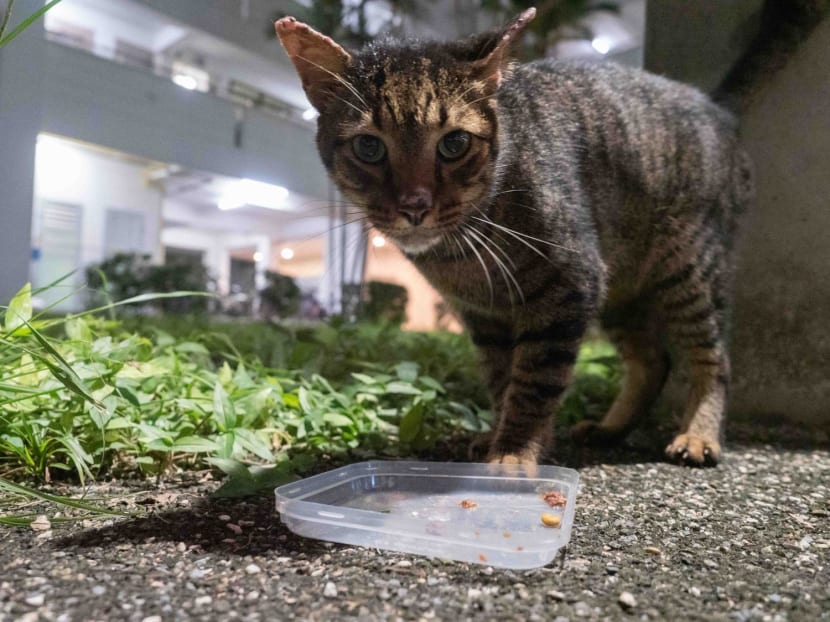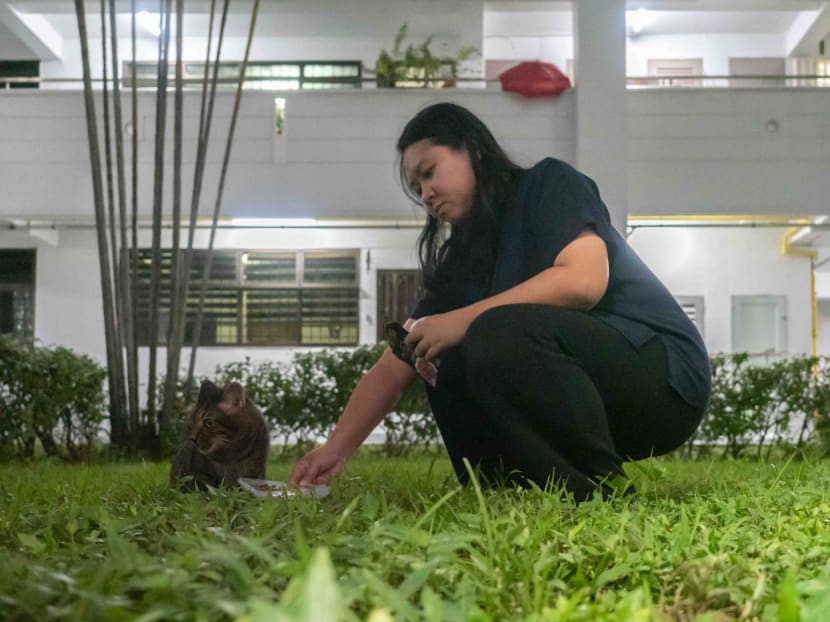'Not an easy job': Community cat feeders say they also pay for sterilisation, medical care of abandoned strays
SINGAPORE – For Linda, her life as a cat feeder began innocently enough. “When I first moved here, there were a lot of stray cats around,” said the 67-year-old housewife, who declined to reveal her full name.

A stray cat in Jurong West.
- Community cats have come into the spotlight after an incident involving a 10-year-old boy who allegedly threw a stray off the 22nd floor
- Neighbourhood cat feeders say few know about how much time, effort and money go into caring for strays
- Apart from cat food, feeders also have to pay to sterilise the animals, and foot their medical bills when they fall ill
- Some feeders say more needs to be done to deter pet owners from abusing or abandoning their cats
SINGAPORE – For Linda, her life as a cat feeder began innocently enough.
“When I first moved here, there were a lot of stray cats around,” said the 67-year-old housewife, who declined to reveal her full name.
“One of the old aunties had been feeding them, so I volunteered to help her. I took over the job (of feeding the cats) when she died.”
Linda has been feeding the cats in her neighbourhood in the northeastern region of Singapore for 22 years now.
She spends around S$400 a month on food for the 10 cats she feeds, all out of her own pocket.
And her job goes beyond feeding the felines.
“I don’t know who keeps abandoning their cats here but as feeders, we have to take care of them and send the cats for sterilisation (to control the population). This is really not an easy job.”
For cat feeders like Ms Carol Tang, 53, her work is not always appreciated, and there are times when she gets scolded by residents for feeding the strays, she said.
“Some even throw water bottles at the community cats. But I have to educate them, and I can’t retaliate against them because I’m afraid they’ll do something bad to the cats,” said Ms Tang.
"We also have to teach residents like children on how to interact with the cats whenever we see them playing with them too roughly, like when they pull on their tails for attention," said Ms Sheereen Yeo, 32, another cat rescuer and feeder.
Community cats are a common sight in Singapore estates, with feeders and rescuers affectionately naming and taking care of their furry neighbours.
Recently, these community cats came into the spotlight after closed-circuit television footage surfaced of a 10-year-old boy allegedly tossing a community cat off the 22nd floor of a Housing and Development Board (HDB) block in Boon Lay.
Cat lovers from every corner of the country banded together demanding justice for the deceased stray named Panther.
BEHIND THE SCENES
Few know about how much time, effort and money go into caring for these strays, cat feeders told TODAY.
Apart from spending hundreds of dollars on cat food alone, feeders also have to make time for daily trips downstairs for feedings and to change the cats' water in their bowls.
Ms Tang said that feeding cats is not as simple as dropping by once a day to leave food for the strays.
“Rescuers like myself have to feed responsibly. We put the food on a plate, then when the cats finished eating, we clean up the place before we leave,” said the information security analyst.
Ms Yeo said that they have to clear the leftover food to prevent pests, such as ants and rats, from being attracted to the cat food.
When pests invade neighbourhoods, deterrents such as rat poison are often used to clear them. But such measures often result in stray cats accidentally ingesting the rat poison, making them sick, Ms Yeo added.
And when cats fall sick, for whatever reason, the amount these feeders have to fork out for treatment can be high.
Ms Tang, who has rescued 14 strays and feeds 11 others on a daily basis, recalled a rescue case she handled recently.
“We took the cat for sterilisation and put her in a boarding place for fostering while we looked for a home for her,” she said.
“But after a while, we found that she was not well, she wasn’t eating anymore and was acting restless. So we took her back to the vet and they found that she had multiple inflammations in several organs.
“We put her through intensive treatment for three months and did ultrasounds and other tests. It ended up costing us S$10,000.”
CAT ABANDONMENT AND ABUSE
Ms Yeo fondly showed TODAY photos of one of her past rescues, an orange cat named Orleng that had once been severely abused, with old scars on its face.
“Cat rescuing is very fulfilling, knowing that your cat is getting better, (but) it’s never easy having to deal with the deaths… I put the experience and the knowledge that I have from my past cases into my current cases and try my best to care for my current cases,” she said.
These cat feeders hope that the authorities can take a tougher stance against those who abandon or abuse cats.
“They have to step up, educate the public and enforce the rules because we as rescuers don’t have the authority to go after abusers,” said Ms Tang.
In cases of abandonment, Ms Yeo believes that cat owners need to be held responsible for their actions.
“In order for that to happen, society needs to impose harsher laws and punishments against owners who abandon their cats. Because ultimately, I think a high abandonment rate does lead to higher cases of abuse,” she said.
Ms Yeo feels that allowing cats to be kept in HDB flats is the way to go.
“Once you legalise it, you (make it mandatory) to microchip your cats. And once you do that, actions can be traced back to the owners,” she said.
Since 1989, cats have not been approved as pets for HDB residents, for reasons such as the difficulty of containing the animals with a flat, and the inconvenience caused to other residents when they are allowed to roam.
However, the Animal and Veterinary Service (AVS) has recently been seeking feedback from the public on proposed measures to improve cat welfare, which could possibly include allowing cats in HDB flats.
The public consultation, which began in September 2022, will end in March.

PET ABANDONMENT CASES RISE DURING FESTIVE SEASONS
The AVS, the arm of the National Parks Board (NParks) that upholds animal health and welfare in Singapore, investigated 279 alleged cases of pet abandonment in 2022 (as of Nov 30).
This compares to 225 alleged cases in 2021 and 215 in 2020.
In response to TODAY’s queries, AVS group director Jessica Kwok said that although the figures look like they’re trending upwards, the organisation does not see any notable increase in the number of cases as “95 per cent of reported cases are not substantiated”.
The Society for the Prevention of Cruelty to Animals (SPCA) said that it receives 60 suspected cases of abandonment yearly.
During the festive seasons, it has also observed an increase in suspected abandoned animals and the number of people wanting to surrender their pets to the SPCA.
Ms Aarthi Sankar, executive director of the SPCA, advises the public against buying or adopting an animal as a gift during the festive season.
“The recipients of these gifts may not be fully ready for the lifetime commitment of caring for a pet. As such, the SPCA strongly encourages people to deeply consider the various resources such as time, money and space required to care for an animal before purchasing or adopting an animal,” she said.
Similarly, Ms Thenuga Vijakumar, president of the Cat Welfare Society, said that her organisation sees a “gentle spike in anecdotal feedback and reports of suspected pet abandonment during the end of year and festive periods”.
“When a cat is purchased or given, people do not necessarily understand the expectations (hence) those cats are at higher risk of abandonment,” she said.









